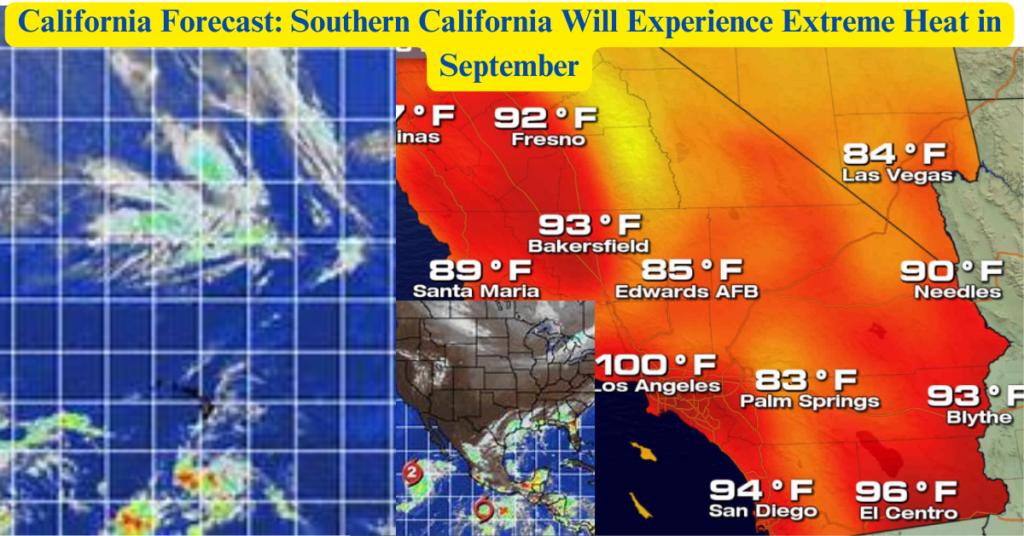
California Forecast: Southern California Will Experience Extreme Heat in September
Table of Contents
An Introduction
California Forecast: Southern California Will Experience Extreme Heat in September. California’s weather has always been known for its varied and unpredictable character. However, what is predicted for Southern California in September 2024 may be worrisome not only for the residents of this region but for the entire state. Temperatures in Southern California are likely to rise to dangerous levels during this month, leading to heat wave-like conditions. This situation may not only have adverse effects on health but may also have serious consequences on the environment and the economy.
LOS ANGELES – Although the official start of fall is just a few weeks away, September has already kicked off with blistering heat in Southern California, and the sweltering heat is set to continue for the next several days.
Southern California Weather:
Southern California, which is famous for its golden beaches, bright sunshine, and comfortable weather, also experiences extreme diversity in terms of weather. Summers in the region are hot and dry, while winters are mild and relatively humid. California’s geographical location and its maritime influence result in a unique mix of weather conditions. However, in recent years, the effects of climate change have made the region’s weather even more unpredictable and extreme.

Possibility of a September heat wave
Meteorologists and climate experts have warned that Southern California could experience extreme heat waves during September 2024. Temperatures could rise well above normal in this heat wave, posing a serious threat to both the region’s residents and the environment. Such heat waves typically last for several days or weeks, with temperatures rising above 100 degrees Fahrenheit (38 degrees Celsius).
Adverse health effects
This type of extreme heat is not only uncomfortable, but it can also pose a serious health risk. During heat waves, it becomes difficult for the body to regulate temperature, leading to heat stroke, heat exhaustion, and dehydration. Older individuals, children, pregnant women, and people with underlying health conditions are particularly vulnerable.
Heat Stroke and Heat Exhaustion
Heat stroke is a condition in which the body temperature rises excessively and requires immediate medical attention. This condition occurs when the body’s temperature control system stops working. Its symptoms can include high fever, dry skin, dizziness, and fainting. Heat exhaustion, on the other hand, is caused by a loss of water and salt in the body, which can result in weakness, headaches, and nausea.
Dehydration and Other Problems
Dehydration is also a common problem during extreme heat, especially when people do not drink enough water. Dehydration can cause headaches, fatigue, and irritability. In addition, the risk of heart diseases also increases during this type of heat, as the heart has to work harder to keep the body cool.
Environmental impacts
The heat wave that is coming to Southern California can not only have an adverse effect on human health, but it can also have a profound impact on the environment. Extreme heat can increase the demand for water resources, while increasing the pressure on water sources. In addition, it can also have an adverse effect on wildlife and plant life.
Water crisis
Southern California is an arid region, where water scarcity is already a major problem. Extreme heat can lead to an increase in water consumption, which can lead to a water crisis. The lack of water resources will not only affect human life, but it will also have a negative impact on agriculture, industry, and wildlife. Increased demand for water for irrigation can also have a serious impact on farming, leading to a decrease in food production.
Effects on wildlife
Wildlife can also face serious crisis during heat waves. Extreme temperatures can cause animals to be displaced from their natural habitats. Water scarcity and high temperatures can increase the mortality rate of wildlife, while also reducing the availability of their food. In addition, vegetation growth can also be affected due to heat, which can disturb the environmental balance.
Possibility of forest fires
Extreme heat and dry weather in Southern California also increases the possibility of forest fires. The region is already prone to forest fires, and the incidence of fires can increase during such heat waves. Forest fires not only damage the environment but can also pose a serious threat to human life and property.
Impact on the economy
Such extreme weather events not only affect human health and the environment, but also have a wide-reaching impact on the economy. The economy of Southern California is based on tourism, agriculture, and service industries, which can be affected by such heat waves.
Tourism Industry
Southern California’s tourism industry is based on its beautiful beaches, national parks, and amusement parks. However, during extreme heat, the number of visitors may decline, causing losses to the tourism industry. In addition, those tourists who do visit may also stay for a shorter period of time due to the heat, which can also harm local businesses.
Effects on Agriculture
California’s agriculture industry is one of the largest in the country, and Southern California also contributes significantly to it. However, extreme heat can lead to a decrease in crop production, causing economic losses for farmers. Lack of water for irrigation and high temperatures can adversely affect the quality and quantity of crops.
Energy Demand and Supply
Heat can cause an increase in demand for air conditioning and other cooling equipment, which can increase energy consumption. This type of extreme demand can put pressure on the energy grid, causing power outages or increased energy prices. In addition, extreme heat can also affect the efficiency of energy production plants, which can lead to a reduction in energy supply.
Social and cultural impacts
These types of extreme weather events also have a profound impact on society and culture. Extreme heat can lead to a decrease in social mobility, which can lead to a decrease in communication and interaction between communities. In addition, public events and activities may be cancelled or postponed, which can lead to disruptions in social and cultural life.
Pressure on health services
Health services can be put under pressure during heat waves, as cases of heat stroke, dehydration, and other heat-related illnesses may increase. The number of patients in hospitals and clinics may increase, leading to a shortage of medical resources. In addition, extreme heat can also increase the demand for medicines and medical equipment, which can increase the cost of health services.
Community support and disaster management
During these types of extreme weather events, communities need to work together. Local governments and organizations should prepare disaster management plans to ensure the safety of people during heat waves. Community centers, schools, and other public places can be used as cooling centers where people can escape from extreme heat. In addition, awareness campaigns need to be conducted and information provided to communities so that people can understand and follow heat protection measures.
Possible Solutions and Preventive Measures
To deal with the heat wave that is expected in September 2024 in Southern California, it is necessary that the government, organizations, and communities work together. Several measures can be adopted to address this problem, which will not only help in reducing the current crisis but can also reduce the impact of such events in the future.
Water Conservation
Water conservation is an important step to reduce water crisis. People should adopt water saving measures in their homes and communities, such as using water-efficient appliances, fixing leakages, and limiting non-essential water use. In addition, governments should make long-term plans to manage water resources so that water crisis can be tackled.
Reducing energy consumption
Reducing energy consumption is also important during the heat. People can use energy-efficient appliances and turn off non-essential appliances to reduce energy consumption in their homes. In addition, governments and organizations should encourage energy conservation measures and run awareness campaigns to reduce energy demand.
Supporting healthcare services
It is also necessary to support healthcare services so that people can get proper medical help during extreme heat. Governments should provide additional resources to hospitals and clinics so that they can meet the increased demand. In addition, healthcare workers should be trained to treat extreme heat-related illnesses.
Community cooperation and support
Communities need to work together to deal with the heat wave. Local organizations and community groups should run programs to help people, such as setting up cooling centers, distributing water, and assisting the elderly and other vulnerable individuals. In addition, efforts should also be made to increase community education and awareness, so that people understand and follow heat protection measures.

Conclusion
California Forecast: Southern California Will Experience Extreme Heat in September Forecast:
Southern California Will Experience Extreme Heat in September .The scorching heat expected in September 2024 in Southern California poses a serious challenge not only to health, but also to the environment, economy, and society. Dealing with such heat waves requires collective efforts, in which the government, organizations, and communities all have to work together. Considering the effects of climate change, there is a need to adopt long-term solutions and implement preventive measures, so that the impact of such events can be reduced in the future.
California residents have to be careful, and they should take all the necessary steps to avoid this heat wave. Climate Change
Weather Alert
Excessive Heat Warning
The excessive heat warning will be in effect from 11 a.m. Wednesday to 9 p.m. Friday in the Inland Empire, where temperatures will reach triple digits. Residents are urged to stay in air-conditioned rooms, stay hydrated and minimize going outside.
The warning will also apply to many Southern California communities in Los Angeles, Ventura and Orange counties, including Beverly Hills, Lancaster, Pyramid Lake, Valencia, Los Angeles, Compton, Culver City, East L.A., Glendale, Hollywood, Simi Valley, Ocoee, Pomona, Pasadena, areas along the Angeles Crest Highway.
It also applies to inland areas of Orange County, including Anaheim, Santa Ana, Mission Viejo, Fullerton, Orange, Irvine and Garden Grove.


